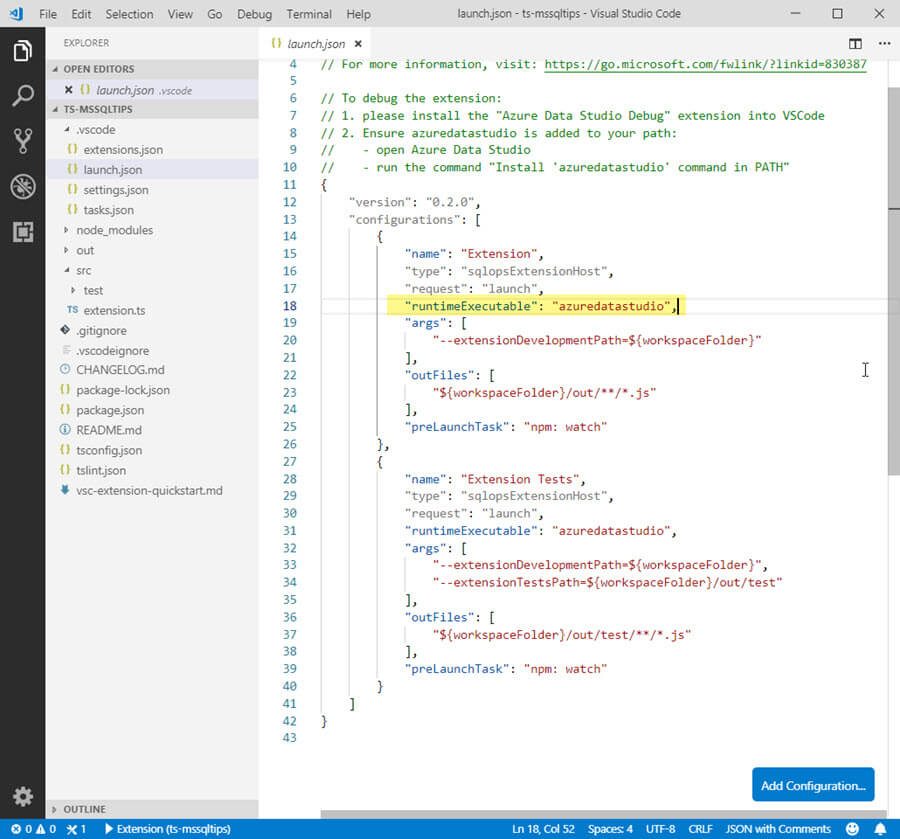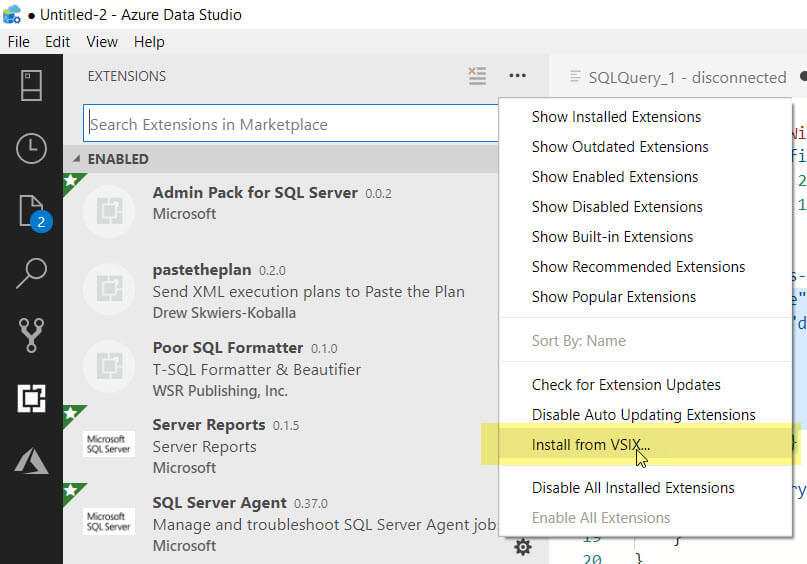

- #Azure data studio extensions for free#
- #Azure data studio extensions install#
- #Azure data studio extensions code#
Azure Extensions - The VS Code Marketplace has hundreds of extensions for Azure and the cloud.Once the cluster is created, connect to using the connection string provided by MongoDB Atlas.

#Azure data studio extensions for free#
You can easily create a MongoDB cluster on Azure for Free with MongoDB Atlas.Ĭhoose Create a New Cluster from the dashboard and choose Azure as the Cloud Provider.

Execute selected lines in the playground queries with the MongoDB: Run Selected Lines From Playground command. Playgrounds are useful for prototyping database operations and queries. In a playground, you can reference MongoDB entities and commands and you get rich IntelliSense as you type. Create a new playground with the MongoDB: Create MongoDB Playground command. Playgrounds let you create, run, and save MongoDB commands from a VS Code editor. One of the most powerful features of the VS Code MongoDB integration is Mongo Playgrounds. There are MongoDB specific commands available in the VS Code Command Palette ( ⇧⌘P (Windows, Linux Ctrl+Shift+P)) as well as through Explorer context menus. In the extension's settings, you can choose which shell you are using. Note: Make sure the MongoDB shell ( mongo or mongosh) is installed and is on your path. You can also attach a MongoDB shell to the active connection, simply by right-clicking on the connection itself. You can expand databases to view their collections with their schema and indexes and you can select individual MongoDB Documents to view their JSON. Once attached, you can work with the MongoDB server, managing MongoDB Databases, Collections, and Documents. Note: Make sure your MongoDB server (mongod.exe) is running if you are connecting to a local MongoDB server. You can also enter a connection string, click the "connect with a connection string" link and paste the connection string. To connect to a MongoDB database, select Add Connection and enter the connection details for the database then Connect, the default is a local MongoDB server at mongodb://127.0.0.1:27017. Select the MongoDB view and you'll see the MongoDB Explorer. Once you've installed the MongoDB for VS Code extension, you'll notice there is a new MongoDB Activity Bar view. Select the MongoDB for VS Code extension.
#Azure data studio extensions install#
To install the MongoDB for VS Code extension, open the Extensions view by pressing ⇧⌘X (Windows, Linux Ctrl+Shift+X) and search for 'MongoDB' to filter the results. MongoDB support for VS Code is provided by the MongoDB for VS Code extension. With the MongoDB for VS Code extension, you can create, manage, and query MongoDB databases from within VS Code. Visual Studio Code has great support for working with MongoDB databases, whether your own instance or in Azure with MongoDB Atlas. Configure IntelliSense for cross-compiling.You’ll get a message stating everything is fine and then you’ll be able to head back to ADS and carry on with the final statements they will query the database. Simply navigate to the link, authenticate using a Microsoft account and type in the code. When you run the cell, you’ll be given a code and a link to a Microsoft site. %kql AzureDataExplorer://tenant=”” code cluster=’help’ database=’Samples’ The next part require authentication – but all you require is a Microsoft account (outlook, hotmail ect) !pip install Kqlmagic –no-cache-dir –upgrade The first two code cells, just set up KQL for us I’m going to summarize the instructions in this post and add my take to them, if you want to switch to that post (or use the two combined) feel free. If you don’t have a python installation then don’t worry, as soon as we execute our first command then ADS will prompt you to install one. Now select “New Notebook” – then select the Python Kernel Open Azure Data Studio (ADS) and install KQL addin. The cluster that we will link too will be the same one that we previously used when we link to an ADX cluster via the Azure Portal. In this post, I want to look at doing a similar thing, but this time using Azure Data Studio (ADS). One of my previous blogs looked at using the free resources that Microsoft provides to link to an Azure Data Explorer Cluster and start using Kusto Query Language.


 0 kommentar(er)
0 kommentar(er)
